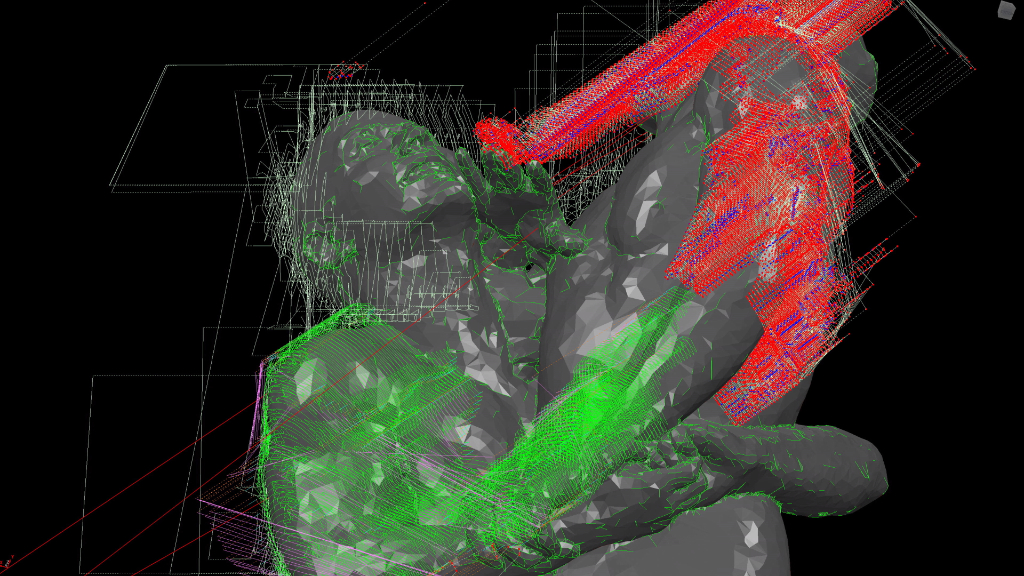Text by Irem Erkin

Fighters is a new film and sculpture by Italian multimedia visual artist Quayola, created for Max Cooper’s latest musical project, Seme (or Seed). This project explores the foundations of nature and society. The short film captures the impressive fusion of computer programming and classical Italian art, extending Cooper’s artistic commission by the prestigious Salzburg Easter Festival uncovering historical aesthetics through a contemporary lens.
Like electronic composer Max Cooper, Quayola’s artworks are influenced by technology. Quayola creates algorithmically generated experiences focusing on the relationship between visual and auditory inputs explored through digital and analogue formats. The film Fighters is soundtracked by Palestrina Sicut, a piece from Max Cooper’s Seme EP. This composition features an esoteric palette of synths and piano, whose intimate warmth is enriched by poignant and significant elements, establishing a conversational flow between traditional and electronic musicians.
This collaboration demonstrates the harmonious fusion of art and technology. Inspired by Michelangelo’s Captives (1510-1530), a series of unfinished sculptures celebrated for their expressiveness and visible creation process, Quayola told us via email that his inspiration was drawn from the historical, artistic context of the Italian Renaissance.
Quayola’s art reflects on contemporary and future relationships with technology, exploring how these relationships shape new perspectives on the world. Growing up in Rome, Quayola explained that he was deeply influenced by the city’s historical and artistic heritage. His return to Rome aims to reconnect with these timeless sources of inspiration. My interest, however, is not to use technology to reproduce objects from the past; on the contrary, I am interested in using these historical references as catalysers to produce new aesthetics, new objects of contemplation that talk about our present. He remarks.
One striking example of this is his marble sculpture Fighters, which embodies the concept of algorithmic genesis. The precision of robotics introduces a new dimension to traditional art forms, celebrating a novel type of expressive sculptural gesture. Unlike others who use robots to carve predetermined geometries, Quayola’s sculptures represent the robotic process itself. He believes that special works emerge when artists find personal ways to work with technology rather than simply using the latest technology without a personal vision. Michelangelo’s unfinished sculptures Captives focus on articulating matter and the harmonious tensions between form and matter. Likewise, Quayola’s works document specific processes, using technology to discover new expressive gestures.
Quayola’s visual artistry and Cooper’s music intersect in Fighters’ short film, creating a profound synergy. The video captures the various steps involved in the sculpture’s creation, harmonising these different contexts through the structure provided by Cooper’s music. The music dictated the timing of the processes, aligning the diverse elements into a cohesive narrative.
Max Cooper told us that the process began with a search for historic Italian music to be part of the Seme project. Amongst a lot of pomposity built for royalty and grandeur, Palestrina stood out with simplified beauty, it was full of musical forms that resonated with me and which could lend themselves to my form of music.


Cooper explained that Palestrina Sicut takes inspiration from the sacred nature of Palestrina’s music, merging historical elements with contemporary music. He sought to create a simplified beauty from Palestrina’s original scores in which he worked with Neil Orens, returning them into a modern scale to avoid overtly religious connotations while preserving the harmonic structure. By slowing down the harmonic progressions, Cooper aimed to enhance the meditative nature of the music. Synths and improvised vocalisations by Sarah Aristidou and Kim Sheehan recreated layers of harmony, drawing away from literal church connections to focus on reflection and beauty.
The themes of reflection and meaning in Cooper’s music resonate deeply with his artistic vision. Written for reflection and awe, the music’s harmonic progressions convey feelings intuitively, creating an immersive space for listeners to allow their thoughts to flow freely. This interaction between sensory modalities enhances the overall narrative, combining Italian artistic heritage with modern aesthetics in a harmonious blend.
Cooper ended this conversation explaining that Seme emerged from a commission with an Italian theme, blending Cooper’s interests in sciences and arts, hence the Palestrina connection, but I was also looking for references to other Italian arts in a modern setting, so I went straight to Quayola, one of my favourite artists, who also has Italian connections. The inclusion of Quayola added a foundational aesthetic to the project. The collaboration between Quayola and Cooper demonstrates how contemporary art can draw from historical roots while pioneering new directions, creating works that resonate with both the past and the present.





